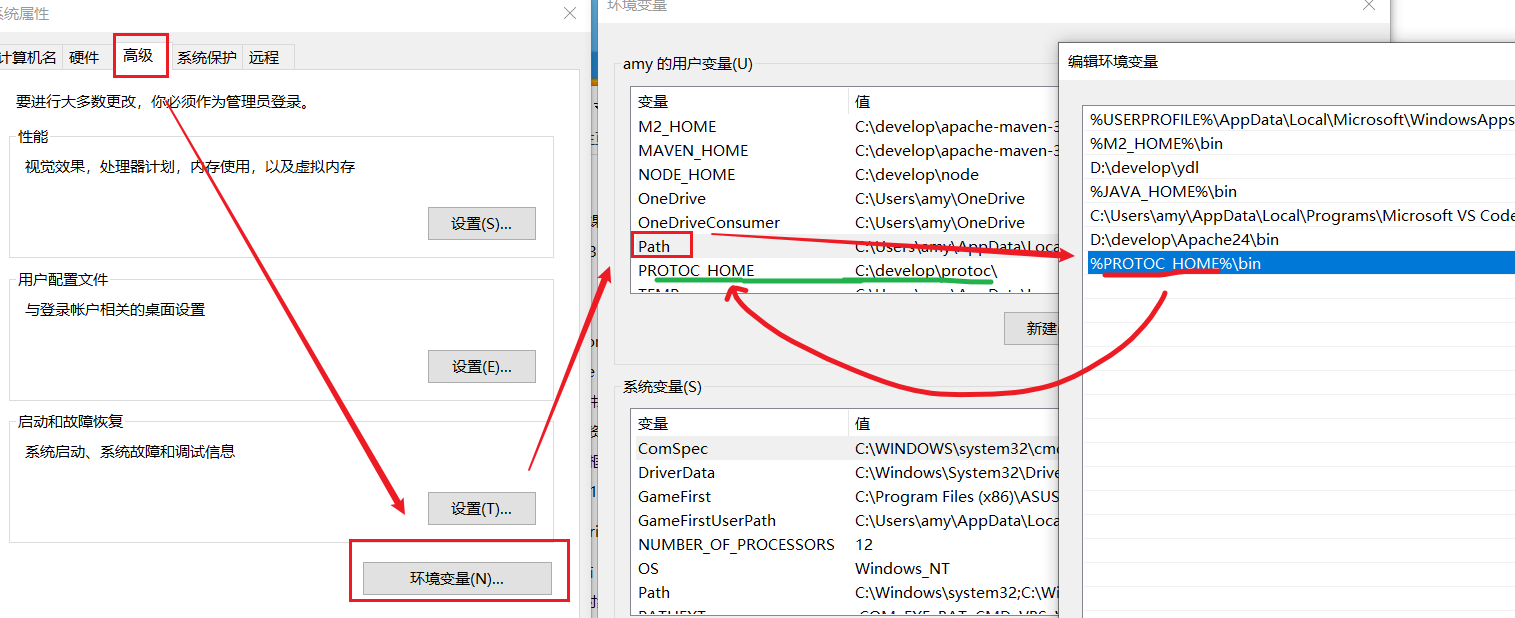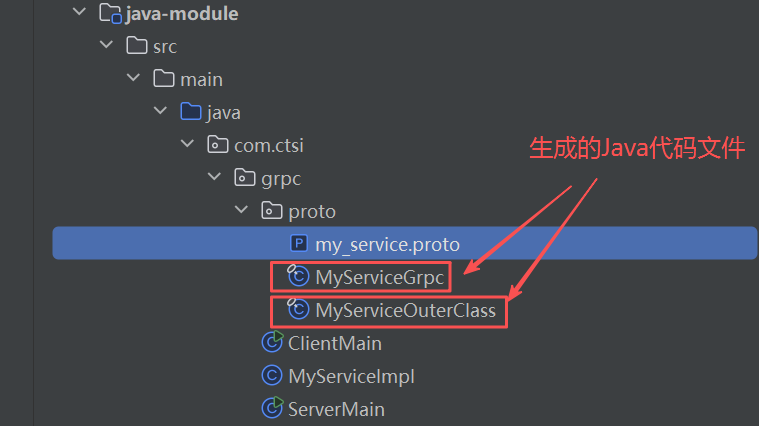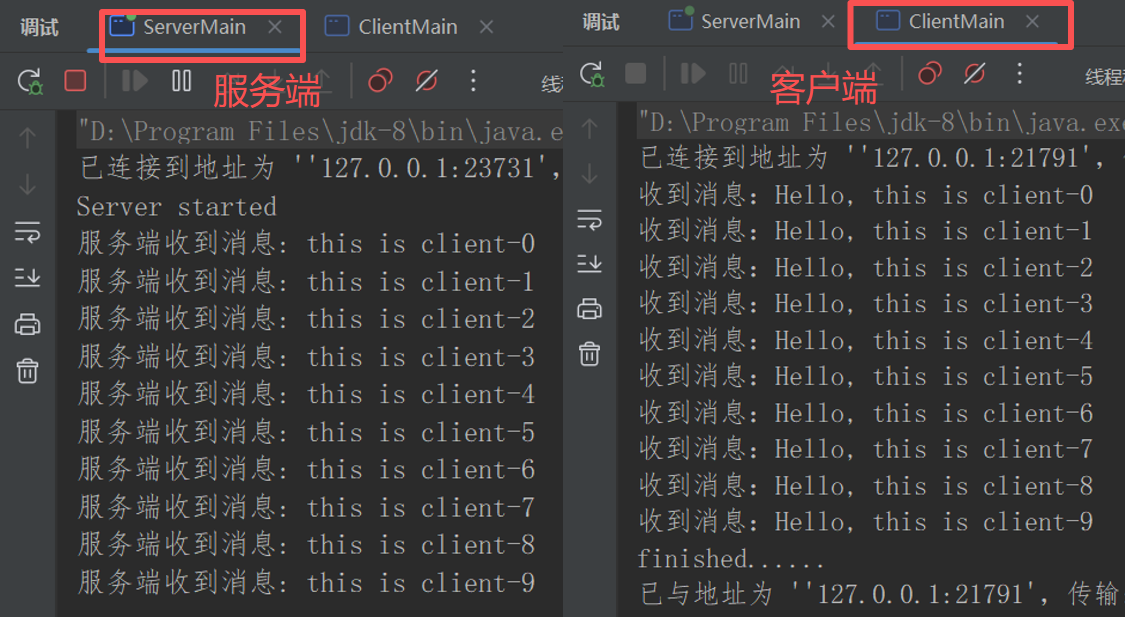1、引入依赖项
xml
<properties>
<maven.compiler.source>8</maven.compiler.source>
<maven.compiler.target>8</maven.compiler.target>
<project.build.sourceEncoding>UTF-8</project.build.sourceEncoding>
<grpc.version>1.64.2</grpc.version>
</properties>
<dependencies>
<!-- @Slf4j日志-->
<!-- <dependency>-->
<!-- <groupId>org.projectlombok</groupId>-->
<!-- <artifactId>lombok</artifactId>-->
<!-- <version>1.18.28</version>-->
<!-- </dependency>-->
<!-- @Slf4j日志【这里没有SpringBoot自动引入依赖, 手动引入全部依赖】-->
<dependency>
<groupId>org.slf4j</groupId>
<artifactId>slf4j-api</artifactId>
<version>1.8.0-beta4</version>
</dependency>
<dependency>
<groupId>org.slf4j</groupId>
<artifactId>slf4j-log4j12</artifactId>
<version>1.8.0-beta4</version>
</dependency>
<dependency>
<groupId>log4j</groupId>
<artifactId>log4j</artifactId>
<version>1.2.17</version>
</dependency>
<!-- gRPC 和 Protocol Buffers 的依赖-->
<dependency>
<groupId>io.grpc</groupId>
<artifactId>grpc-netty-shaded</artifactId>
<version>${grpc.version}</version>
</dependency>
<dependency>
<groupId>io.grpc</groupId>
<artifactId>grpc-protobuf</artifactId>
<version>${grpc.version}</version>
</dependency>
<dependency>
<groupId>io.grpc</groupId>
<artifactId>grpc-stub</artifactId>
<version>${grpc.version}</version>
</dependency>
<dependency>
<groupId>io.grpc</groupId>
<artifactId>grpc-util</artifactId>
<version>${grpc.version}</version>
</dependency>
<dependency>
<groupId>com.google.api.grpc</groupId>
<artifactId>proto-google-common-protos</artifactId>
<version>2.17.0</version>
</dependency>
<!--添加 annotation 注解相关的依赖-->
<dependency>
<groupId>javax.annotation</groupId>
<artifactId>javax.annotation-api</artifactId>
<version>1.3.2</version>
</dependency>
<!--添加 Protobuf 依赖, 确保 Protobuf 插件版本与 protobuf-java 版本兼容-->
<dependency>
<groupId>com.google.protobuf</groupId>
<artifactId>protobuf-java</artifactId>
<!-- <version>3.22.3</version>-->
<version>4.33.0</version>
</dependency>
</dependencies>
<build>
<extensions>
<extension>
<groupId>kr.motd.maven</groupId>
<artifactId>os-maven-plugin</artifactId>
<version>1.5.0.Final</version>
</extension>
</extensions>
<plugins>
<!-- reuse when you need to update grpc model -->
<plugin>
<groupId>org.xolstice.maven.plugins</groupId>
<artifactId>protobuf-maven-plugin</artifactId>
<version>0.6.1</version>
<configuration>
<!-- <protocArtifact>com.google.protobuf:protoc:3.22.3:exe:${os.detected.classifier}</protocArtifact>-->
<protocArtifact>com.google.protobuf:protoc:4.33.0:exe:${os.detected.classifier}</protocArtifact>
<pluginId>grpc-java</pluginId>
<pluginArtifact>io.grpc:protoc-gen-grpc-java:1.64.2:exe:${os.detected.classifier}</pluginArtifact>
</configuration>
<executions>
<execution>
<goals>
<goal>compile</goal>
<goal>compile-custom</goal>
</goals>
</execution>
</executions>
</plugin>
</plugins>
</build>2、编写 my_service.proto 文件
java
syntax = "proto3";
package com.ctsi.grpc.proto;
// 创建一个.proto文件来定义你的 gRPC 服务和消息:
// 代码定义了一个名为 MyService 的服务,其中有一个名为 BidirectionalStream 的方法,它接收一个MyRequest流并返回一个MyResponse流。
// MyRequest和MyResponse都包含一个名为message的字段。
// 进入项目的根目录,命令行运行以下命令,生成Java代码:
// protoc -I./ --java_out=./src/main/java/ --grpc-java_out=./src/main/java/ ./src/main/java/com/ctsi/grpc/proto/my_service.proto
// 说明:执行上述命令,系统需安装:1、安装 protoc 2、安装 gRPC Java 插件,参考: https://zhuanlan.zhihu.com/p/1893702967716213732
service MyService {
rpc BidirectionalStream (stream MyRequest) returns (stream MyResponse) {}
}
message MyRequest {
string message = 1;
}
message MyResponse {
string message = 1;
}3、生成Java代码(生成协议)
3.1 安装 protoc
Protobuf 的 GitHub 地址:https://github.com/protocolbuffers/protobuf/releases
我们可以下载其中的windows版本的来使用,解压到任意非中文目录下,其中的bin目录中的protoc.exe可以帮助我们编译:

3.2 安装插件 protoc-gen-grpc-java
插件下载地址:https://link.zhihu.com/?target=https%3A//repo1.maven.org/maven2/io/grpc/protoc-gen-grpc-java/1.64.2/
选择自己的系统环境匹配的文件下载,下载后解压到和protoc同样的目录,因为这个目录已经添加到环境变量path中,否则你得再添加一个path环境变量
3.3 进入项目的根目录,运行以下命令,生成Java代码(生成协议)
bash
protoc -I./ --java_out=./src/main/java/ --grpc-java_out=./src/main/java/ ./src/main/java/com/ctsi/grpc/proto/my_service.proto
4、编写实现服务接口的类 MyServiceImpl
该段代码实现了MyServiceGrpc.MyServiceImplBase抽象类,并重写了bidirectionalStream方法。该方法返回一个StreamObserver对象,用于处理客户端发送的流式请求,并反馈流式响应。
java
package com.ctsi.grpc;
import com.ctsi.grpc.proto.MyServiceGrpc;
import io.grpc.stub.StreamObserver;
import com.ctsi.grpc.proto.MyServiceOuterClass.MyRequest;
import com.ctsi.grpc.proto.MyServiceOuterClass.MyResponse;
/**
* 该类实现了MyServiceGrpc.MyServiceImplBase抽象类,并重写了bidirectionalStream方法。
*/
public class MyServiceImpl extends MyServiceGrpc.MyServiceImplBase {
/**
* 该方法返回一个StreamObserver对象,用于处理客户端发送的流式请求,并发送流式响应。
*
* @param responseObserver 发送流式响应给客户端
* @return StreamObserver对象,用于接收客户端发送的流式请求,并发送流式响应。
*/
@Override
public StreamObserver<MyRequest> bidirectionalStream(StreamObserver<MyResponse> responseObserver) {
return new StreamObserver<MyRequest>() {
@Override
public void onNext(MyRequest request) {
// 接收客户端发来的消息
String message = request.getMessage();
System.out.println("服务端收到消息: " + message);
// 构造并发送响应消息
MyResponse response = MyResponse.newBuilder().setMessage("Hello, " + message).build();
responseObserver.onNext(response);
}
@Override
public void onError(Throwable t) {
// 处理错误
responseObserver.onError(t);
}
@Override
public void onCompleted() {
// 完成双向流
responseObserver.onCompleted();
}
};
}
}5、编写一个gRPC服务器的类,并启动
创建一个gRPC服务器,并将 MyServiceImpl 服务添加到服务器中。服务器监听50051端口,并在启动后等待终止
java
package com.ctsi.grpc;
import io.grpc.Server;
import io.grpc.ServerBuilder;
import java.io.IOException;
public class Server{
public static void main(String[] args) throws IOException, InterruptedException {
Server server = ServerBuilder.forPort(50051)
.addService(new MyServiceImpl())
.build();
/// 服务端启动
server.start();
System.out.println("Server started");
/// 服务端阻塞等待
server.awaitTermination();
System.out.println("Server stoped !");
}
}6、编写一个gRPC客户端的类,并启动
创建一个GRPC客户端来调用上面的服务
java
package com.ctsi.grpc;
import com.ctsi.grpc.proto.MyServiceGrpc;
import com.ctsi.grpc.proto.MyServiceOuterClass;
import io.grpc.ManagedChannel;
import io.grpc.ManagedChannelBuilder;
import io.grpc.stub.StreamObserver;
import java.util.concurrent.CountDownLatch;
import java.util.concurrent.TimeUnit;
public class ClientMain {
final static CountDownLatch finishLatch = new CountDownLatch(1);
public static void main(String[] args) throws Exception {
ManagedChannel channel = ManagedChannelBuilder.forTarget("localhost:50051").usePlaintext().build();
MyServiceGrpc.MyServiceStub stub = MyServiceGrpc.newStub(channel);
/// 定义一个流观察者,用于接收消息
StreamObserver<MyServiceOuterClass.MyResponse> streamObserver = new StreamObserver<MyServiceOuterClass.MyResponse>() {
@Override
public void onNext(MyServiceOuterClass.MyResponse myResponse) {
System.out.println("客户端收到消息:" + myResponse.getMessage());
}
@Override
public void onError(Throwable throwable) {
}
@Override
public void onCompleted() {
System.out.println("finished......");
finishLatch.countDown();
}
};
/// 定义一个双向流观察者,用于发送/接收消息
StreamObserver<MyServiceOuterClass.MyRequest> requestObserver = stub.bidirectionalStream(streamObserver);
try {
for (int i = 0; i < 10; ++i) {
MyServiceOuterClass.MyRequest request = MyServiceOuterClass.MyRequest.newBuilder().setMessage("this is client-" + i).build();
// 发送消息
requestObserver.onNext(request);
}
} catch (Exception e) {
System.out.println(e.getMessage());
}
// Mark the end of requests
requestObserver.onCompleted();
finishLatch.await(10, TimeUnit.MINUTES);
}
}服务端和客户端的运行日志
